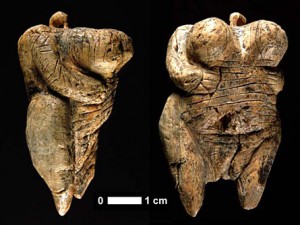Imagine a long early summer sunset, and the only sounds heard are from some late crickets, and the crackling of the fire a few yards away. Venus is shining just under a young moon crescent. Other bright stars are slowly appearing, and the first to be seen is the brightest in the sky, which leads to the coldest parts. As the sky grows darker, a bright milky band shines from where the sun rises to where the moon sets.
A light breeze is blowing; you are thinking of today’s hunt, and tomorrow’s festivities celebrating the sun rising again at that point on the horizon when its path moves back to where it first came six moons ago. A big bird flies off of a nearby tree, and the coming darkness leads you into a dream.
The beauty of the still twilight inspires you to reach into the leather pouch you always keep close to your body. You take out your magic flute and start to blow into it; softly at first, recalling one of the melodies you heard at a gathering long ago near the big ice wall over in the direction of that brightest star in the sky. Then you feel the melody could sound a different way, and you go more deeply into the sounds you are producing.
Others gather: someone has brought a hollow piece of trunk, on which he has stretched a piece of abix skin held tightly by some wood pegs. Its pulse lays a foundation for your improvisation. Some of the people who have gathered around you start to move in unusual ways. Not walking, not running, not expressing a particular feeling– but just moving to the pulse generated by the sounds you and your acolytes are producing.
It is something new, these movements, that previously were static and meant either anger, love, hunger, or danger. But with these sounds you are producing, all of these movements become blended, in a complex meaning that is not so clear but much more nuanced. there were even some that were completely new. They must have meant something, but it was yet not clear to anyone; could it be that these movements could be combined into groups? Everyone was feeling calm, and someone even started making sounds with her mouth in a sequence, repeating the same sound over and over, synchronized with the movements and mysteriously related to your melodies….could that have meaning?
There is so much to discover and understand; somehow that evening it became just a little bit more clear. Definitely a night to remember.
This fictitious but, I think, possible scenario happened a Platonic year* and a half ago in what is now called Ulm in Germany, where Professor Nicholas Conard of Tubingen University found in one location three flutes made of bird bones.
“We report the discovery of bone and ivory flutes from the early Aurignacian period of southwestern Germany. These finds demonstrate the presence of a well-established musical tradition at the time when modern humans colonized Europe, more than 35,000 calendar years ago”.
Experimenting with the replica, he found that the ancient flute produced a range of notes comparable in many ways to modern flutes. “The tones are quite harmonic,” he said (they were pentatonic in nature: a five tone scale which skips the fourth and the seventh degrees of the diatonic scale). He adds:
“It’s becoming increasingly clear that music was a part of day-to-day life,”…. “Music was used in many kinds of social contexts: possibly religious, possibly recreational – much like how we use music today in many kinds of settings.”….”Music could have contributed to the maintenance of larger social networks, and thereby perhaps have helped facilitate the demographic and territorial expansion of modern humans…” his team wrote.
In fact, it is hard to imagine the development of musical abilities without the parallel development of spoken language. There are strong indications that language has its root in singing (I will develop on this concept in a future post).
It so happens that the Hohle Fels flute, as it is called, was uncovered in sediment a few feet away from the carved figurine of a busty, nude woman, which was also estimated to be around 35,000 years old. Now, I’ll let you make your own deductions about this synchronicity.

* A Platonic Year is 24,000 solar years. It corresponds to the period it takes for the earth axis to wobble, like a spinning top in one complete turn. This phenomenon has resulted in a shift of constellations. To an observer on Earth, Vega was the north star, and the Milky Way was flowing in a different direction.
